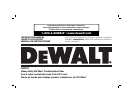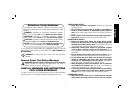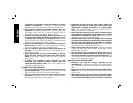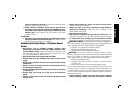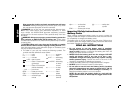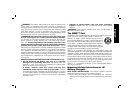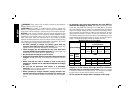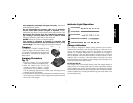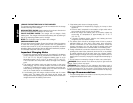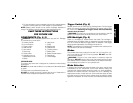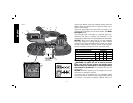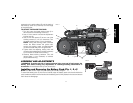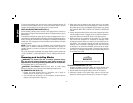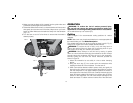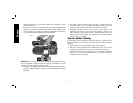
5
English
WARNING: Fire hazard. Never attempt to open the battery pack
for any reason. If the battery pack case is cracked or damaged, do
not insert into the charger. Do not crush, drop or damage the battery
pack. Do not use a battery pack or charger that has received a sharp
blow, been dropped, run over or damaged in any way (e.g., pierced
with a nail, hit with a hammer, stepped on). Damaged battery packs
should be returned to the service center for recycling.
WARNING: Fire hazard. Do not store or carry the battery pack
so that metal objects can contact exposed battery terminals.
For example, do not place the battery pack in aprons, pockets, tool
boxes, product kit boxes, drawers, etc., with loose nails, screws,
keys, etc. Transporting batteries can possibly cause fi res if the
battery terminals inadvertently come in contact with conductive
materials such as keys, coins, hand tools and the like. The US
Department of Transportation Hazardous Material Regulations (HMR)
actually prohibit transporting batteries in commerce or on airplanes
(e.g., packed in suitcases and carry-on luggage) UNLESS they are
properly protected from short circuits. So when transporting individual
battery packs, make sure that the battery terminals are protected and
well insulated from materials that could contact them and cause a
short circuit.
SPECIFIC SAFETY INSTRUCTIONS FOR LITHIUM ION (Li-Ion)
• Do not incinerate the battery pack even if it is severely
damaged or is completely worn out. The battery pack can
explode in a fi re. Toxic fumes and materials are created when
lithium ion battery packs are burned.
• If battery contents come into contact with the skin,
immediately wash area with mild soap and water. If battery
liquid gets into the eye, rinse water over the open eye for 15 minutes
or until irritation ceases. If medical attention is needed, the battery
electrolyte is composed of a mixture of liquid organic carbonates
and lithium salts.
• Contents of opened battery cells may cause respiratory
irritation. Provide fresh air. If symptoms persist, seek medical
attention.
WARNING: Burn hazard. Battery liquid may be fl ammable if
exposed to spark or fl ame.
The RBRC™ Seal
The RBRC™ (Rechargeable Battery Recycling Corp oration) Seal on the
nickel cadmium, nickel metal hydride or lithium ion
batteries (or battery packs) indicate that the costs to
recycle these batteries (or battery packs) at the end of
their useful life have already been paid by D
EWALT. In
some areas, it is illegal to place spent nickel cadmium,
nickel metal hydride or lithium ion batteries in the trash or
municipal solid waste stream and the RBRC program
provides an environmentally conscious alternative.
RBRC™, in cooperation with D
EWALT and other battery users, has
established programs in the United States and Canada to facilitate the
collection of spent nickel cadmium, nickel metal hydride or lithium ion
batteries. Help protect our environment and conserve natural resources
by returning the spent nickel cadmium, nickel metal hydride or lithium
ion batteries to an authorized D
EWALT service center or to your local
retailer for recycling. You may also contact your local recycling center
for information on where to drop off the spent battery.
RBRC™ is a registered trademark of the Rechargeable Battery
Recycling Corporation.
Important Safety Instructions for All
Battery Chargers
SAVE THESE INSTRUCTIONS: This manual contains important
safety and operating instructions for battery chargers.
• Before using the charger, read all instructions and cautionary
markings on the charger, battery pack and product using the battery
pack.



